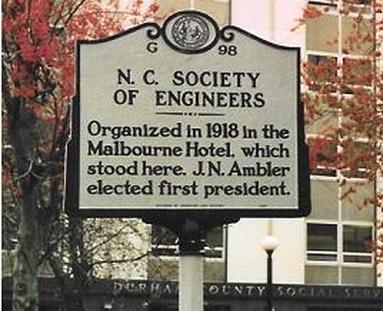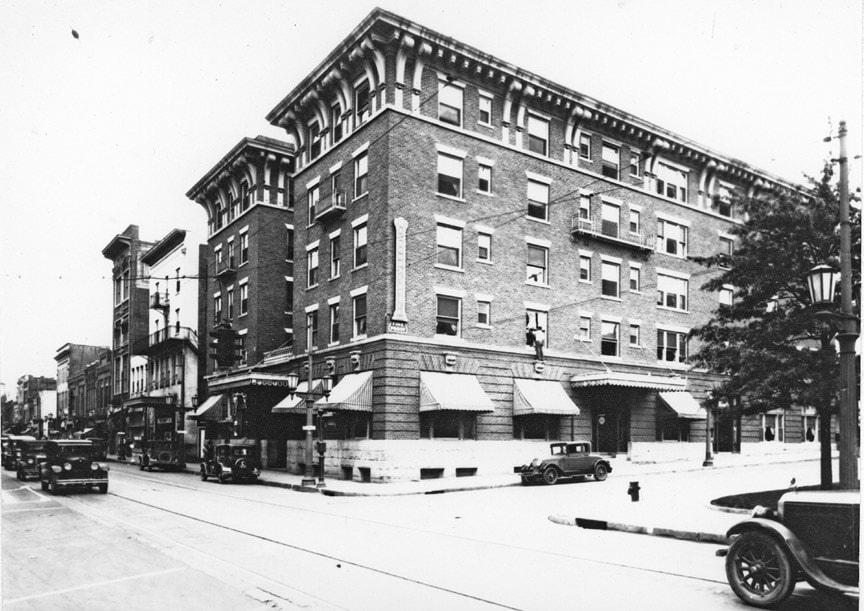In the period just prior to the first World War engineering in all its branches was beginning to make great strides in North Carolina. The various counties were beginning to build roads. Dams for power plants were being built, and cities were installing waterworks and sewer lines. Among the engineering personnel required for this work there were many members of the Founder Engineering Societies, but there was no Statewide organization of these societies.
As early as 1910 the formation of a State Society of Engineers had been discussed, but it was not until 1918 that any definite steps were taken. At the call of Mr. R. E. Snowden, there met in Durham on February 18, 1918, a group of engineers who organized the North Carolina Society of Civil Engineers. This meeting was held at the Malbourne Hotel (razed, in the 1970’s for the construction of the Durham County Courthouse) on the eve of the opening of The Road Institute of Chapel Hill. Mr. Snowden took advantage of this opportunity to call together some of the prominent Civil Engineers of North Carolina.
Mr. John N. Ambler of Winston-Salem was elected the first President, and Dr. W. C. Riddick was vice president.
A constitution was adopted at a meeting held in Greensboro on June 25, 1918. A charter was granted by the State Legislature on June 5, 1919, and the Society became “A corporation for promoting the interests of the engineering profession; for securing better service to the public; disseminating engineering knowledge; bringing about a closer personal acquaintance among engineers; fostering better standards of engineering, etc.”
The first annual meeting was held in Raleigh on February 8, 1919. At the second annual meeting, in January, 1920, the Society decided to affiliate with the American Association of Engineers. The name was changed to N.C. Society of Engineers and Civil, Mechanical, Electrical, and Chemical Engineers were admitted to membership. There were local chapters of the Society in Asheville, Charlotte, Greensboro, and Raleigh. The connection with the American Association of Engineers was terminated at the Annual Convention in Morehead City on August 7-8, 1925.
The Society has sponsored many legislative acts of public benefit and of interest to the Engineering Profession. At a meeting held on December 30, 1918, the board of Directors appointed a committee to investigate the licensing of engineers. Two years later the Engineers License and Registration Law was passed. In 1925 the Society endorsed a proposed bill in the Legislature in regard to the State operating a broadcasting station. Among their legislative acts endorsed or promoted by the Society, were a Sanitary District Bill, a bill providing for the appointment of a Building Code Council, a channel in the Cape Fear River from Wilmington to Fayetteville, a State Triangulation Survey, and various bills to aid cities and towns in securing RFC loans for water and sewer improvements. Considerable aid also was given by the Society in having the salaries of State-employed engineers partially restored in 1935.
A Code of Practice for Engineers was adopted by the Society in 1928. This code was prepared after much study and investigation by the committee appointed by the President of the Society. This committee consisted of C. A. Mess, chairman; J.L. Becton; C.M. Braune; Sherwood Brockwell; C.F. Lewis; J. L. Ludlow, and F.T. Miller.
In August, 1922, the late “Uncle Dan” Ulrich of Wilmington presented the Society bound volumes of the Engineering News Record covering a period of fifteen years. In the annual meeting held January 25-26, 1929, it was moved that: a committee be appointed to sort the records of the Society and to arrange for the deposition at N.C. State College of those worth preservation.
With one exception, the Society has held a meeting in the winter and another during the summer each year. There was no meeting during the summer of 1926 due to failure to arrange a satisfactory date and place with the State branches of the A.S.C.E. and A.S.M.E. as had been planned. Many well-known persons in the field of engineering have addressed the Society, as well as many of our own members. In 1937 the Society awarded the first Annual Certificate for Outstanding Engineering Achievement.
In 1946 the organization established an office at the Engineering School at N.C. State College. The office later relocated to Cameron Village in Raleigh.
As early as 1910 the formation of a State Society of Engineers had been discussed, but it was not until 1918 that any definite steps were taken. At the call of Mr. R. E. Snowden, there met in Durham on February 18, 1918, a group of engineers who organized the North Carolina Society of Civil Engineers. This meeting was held at the Malbourne Hotel (razed, in the 1970’s for the construction of the Durham County Courthouse) on the eve of the opening of The Road Institute of Chapel Hill. Mr. Snowden took advantage of this opportunity to call together some of the prominent Civil Engineers of North Carolina.
Mr. John N. Ambler of Winston-Salem was elected the first President, and Dr. W. C. Riddick was vice president.
A constitution was adopted at a meeting held in Greensboro on June 25, 1918. A charter was granted by the State Legislature on June 5, 1919, and the Society became “A corporation for promoting the interests of the engineering profession; for securing better service to the public; disseminating engineering knowledge; bringing about a closer personal acquaintance among engineers; fostering better standards of engineering, etc.”
The first annual meeting was held in Raleigh on February 8, 1919. At the second annual meeting, in January, 1920, the Society decided to affiliate with the American Association of Engineers. The name was changed to N.C. Society of Engineers and Civil, Mechanical, Electrical, and Chemical Engineers were admitted to membership. There were local chapters of the Society in Asheville, Charlotte, Greensboro, and Raleigh. The connection with the American Association of Engineers was terminated at the Annual Convention in Morehead City on August 7-8, 1925.
The Society has sponsored many legislative acts of public benefit and of interest to the Engineering Profession. At a meeting held on December 30, 1918, the board of Directors appointed a committee to investigate the licensing of engineers. Two years later the Engineers License and Registration Law was passed. In 1925 the Society endorsed a proposed bill in the Legislature in regard to the State operating a broadcasting station. Among their legislative acts endorsed or promoted by the Society, were a Sanitary District Bill, a bill providing for the appointment of a Building Code Council, a channel in the Cape Fear River from Wilmington to Fayetteville, a State Triangulation Survey, and various bills to aid cities and towns in securing RFC loans for water and sewer improvements. Considerable aid also was given by the Society in having the salaries of State-employed engineers partially restored in 1935.
A Code of Practice for Engineers was adopted by the Society in 1928. This code was prepared after much study and investigation by the committee appointed by the President of the Society. This committee consisted of C. A. Mess, chairman; J.L. Becton; C.M. Braune; Sherwood Brockwell; C.F. Lewis; J. L. Ludlow, and F.T. Miller.
In August, 1922, the late “Uncle Dan” Ulrich of Wilmington presented the Society bound volumes of the Engineering News Record covering a period of fifteen years. In the annual meeting held January 25-26, 1929, it was moved that: a committee be appointed to sort the records of the Society and to arrange for the deposition at N.C. State College of those worth preservation.
With one exception, the Society has held a meeting in the winter and another during the summer each year. There was no meeting during the summer of 1926 due to failure to arrange a satisfactory date and place with the State branches of the A.S.C.E. and A.S.M.E. as had been planned. Many well-known persons in the field of engineering have addressed the Society, as well as many of our own members. In 1937 the Society awarded the first Annual Certificate for Outstanding Engineering Achievement.
In 1946 the organization established an office at the Engineering School at N.C. State College. The office later relocated to Cameron Village in Raleigh.

A historical monument was erected in Durham, NC, on March 26, 1986 near the site of the first organizational meeting.
The Society established the Ronald C. Harrell Scholarship Fund on January 21, 2001, to honor Ron who passed away on January 1, 2001. The purpose of the Fund is to help further the field of engineering by providing a scholarship each year to a student enrolled in engineering at a North Carolina College. The Scholarship Fund also provides funds to Local Engineer Clubs who give scholarships.
The Society continues to be strong with a current membership of 200 members dedicated to influencing the future of engineering.
The Society established the Ronald C. Harrell Scholarship Fund on January 21, 2001, to honor Ron who passed away on January 1, 2001. The purpose of the Fund is to help further the field of engineering by providing a scholarship each year to a student enrolled in engineering at a North Carolina College. The Scholarship Fund also provides funds to Local Engineer Clubs who give scholarships.
The Society continues to be strong with a current membership of 200 members dedicated to influencing the future of engineering.


